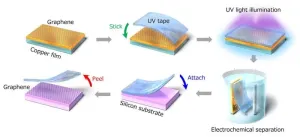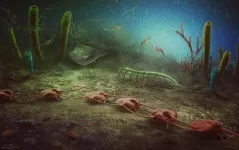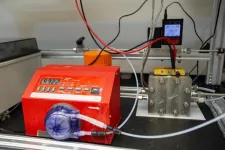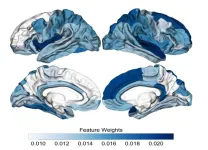(Press-News.org) Scientists have developed a new AI tool that maps the function of proteins in a cancerous tumour, enabling clinicians to decide how to target treatment in a more precise way.
In cancers such as clear cell renal cell carcinoma (ccRCC), responses to existing treatments are different for each patient, making it difficult to identify the right drug treatment regime for each patient.
For example, cancer therapeutic Belzutifan has recently been approved to treat ccRCC, but only has a response rate of 49% in patients with the most common form of the condition.
To understand better why some patients respond better than others, researchers from the Universities of Bath and Nottingham studied the function of Hypoxia-Induced Factor Alpha (HIF2α), a key target of ccRCC that is blocked by Belzutifan.
Previous studies have shown that levels of HIF2α don’t necessarily correspond to the aggressiveness of the tumour, and that counterintuitively when there were greater levels of the protein present, the HIF2α was less active.
This means that administering higher doses of Belzutifan potentially exposes the patient to costly, toxic therapeutics that may not work and could even make the tumour more drug-resistant.
The cross-disciplinary team of biophysicists, biologists and computational scientists has devised a new tool, called FuncOmap, which maps the functional state of target oncoproteins onto the tumour images.
This will enable clinicians to visualise directly the locations in the tumour where oncoproteins are interacting, allowing for more accurate diagnosis and informing the best treatment for each patient.
Professor Banafshé Larijani, Director of the Centre for Therapeutic Innovation at the University of Bath co-led the study. She said: “People respond to drugs very differently.
So it is crucial to be able to predict how patients will respond to drugs individually so a therapy can be tailored to be effective whilst giving the lowest dose to minimise side effects.
“Our new computational analysis tool uses precision to directly map the functional states of oncoproteins in patients’ tumour sections, so that clinicians can improve patient stratification, enabling personalised medicine.”
The team is now collaborating with Dr Amanda Kirane’s Laboratory, as well as other surgeons and clinicians, at Stanford University School of Medicine (USA) to develop and optimise the tool further in the clinical arena.
Professor Eamonn O'Neill, Head of Bath’s Department of Computer Science and Director of UKRI Centre for Doctoral Training in Accountable, Responsible and Transparent AI (ART-AI), said: “This study describes the kind of novel and impactful research that is the essence of working across disciplines.
“It brings together computer science, biology and physics, under the umbrella of the UKRI Centre for Doctoral Training in Accountable Responsible and Transparent Artificial Intelligence, to deliver image analysis that has the capacity to directly inform clinical decision-making and personalised clinical outcomes in cancer treatment as well as other diseases.”
Professor Jonathan Knight FRS, Vice-President (Enterprise) at the University of Bath, said: “The excitement of this paper lies not just in the work being reported, but in its illustration of how linking the research areas of biophysics and translational medicine with modern computational science promises to accelerate the translation of research into valuable tools for the clinical environment. This really amplifies the value to be gained from transdisciplinary studies.”
The study was funded by UKRI Centre for Doctoral Training in Accountable Responsible
and Transparent Artificial Intelligence (ART-AI) [grant number EP/S023437/, Medical Research Council and University of Bath Alumni Fund, and is published in the journal BJC Reports.
END
New tumor spatial mapping tool will help clinicians assess aggressiveness of cancer and personalize treatment
2024-02-09
ELSE PRESS RELEASES FROM THIS DATE:
Certain older Americans show hesitation around brain scan research
2024-02-09
Asian Americans are less likely than their white peers to participate in health research involving MRIs and addressing this hesitancy could improve research, according to a Rutgers Health-led study.
Findings by the researchers, published in Alzheimer's & Dementia: Translational Research & Clinical Interventions, a journal of the Alzheimer’s Association, surveyed older adults about their experiences and perceptions of MRI brain imaging scans, their desire to learn results of scans and their attitudes related to dementia and overall research participation.
According to the study, South Asian older adults – those 65 and older – are less likely than older white adults ...
Migration solves exoplanet puzzle
2024-02-09
Ordinarily, planets in evolved planetary systems, such as the Solar System, follow stable orbits around their central star. However, many indications suggest that some planets might depart from their birthplaces during their early evolution by migrating inward or outward. This planetary migration might also explain an observation that has puzzled researchers for several years: the relatively low number of exoplanets with sizes about twice as large as Earth, known as the radius valley or gap. Conversely, there are many exoplanets smaller and larger than this size.
“Six years ago, a reanalysis of data from the Kepler space telescope revealed a shortage of exoplanets with sizes around ...
New adhesive tape picks up and sticks down 2D materials as easily as child’s play
2024-02-09
Fukuoka, Japan – Materials just atoms in thickness, known as two-dimensional (2D) materials, are set to revolutionize future technology, including in the electronics industry. However, commercialization of devices that contain 2D materials has faced challenges due to the difficulty in transferring these extremely thin materials from where they are made onto the device.
Now, a research team from Kyushu University, in collaboration with Japanese company Nitto Denko, have developed a tape that can be used to stick 2D materials to many different surfaces, in an ...
Researchers discover cosmic dust storms from Type Ia supernova
2024-02-09
Cosmic dust—like dust on Earth—comprises groupings of molecules that have condensed and stuck together in a grain. But the exact nature of dust creation in the universe has long been a mystery. Now, however, an international team of astronomers from China, the United States, Chile, the United Kingdom, Spain, etc., has made a significant discovery by identifying a previously unknown source of dust in the universe: a Type Ia supernova interacting with gas from its surroundings.
The study was published in Nature Astronomy on Feb. 9, and was led by Prof. WANG Lingzhi from the South America Center for Astronomy of the Chinese Academy ...
New fossil site of worldwide importance uncovered in southern France
2024-02-09
Nearly 400 exceptionally well-preserved fossils dating back 470 million years have been discovered in the south of France by two amateur paleontologists. This new fossil site of worldwide importance has been analyzed by scientists from the University of Lausanne, in collaboration with the CNRS and international teams. This discovery provides unprecedented information on the polar ecosystems of the Ordovician period.
Paleontology enthusiasts have unearthed one of the world's richest and most diverse fossil sites from the Lower Ordovician period (around 470 million ...
Global study: Wild megafauna shape ecosystem properties
2024-02-09
For millions of years, a variety of large herbivores, or megafauna, influenced terrestrial ecosystems. Among many others, these included elephants in Europe, giant wombats in Australia, and ground sloths in South America. However, these animals experienced a wave of extinctions coinciding with the worldwide expansion of humans, leading to dramatic but still not fully understood changes in ecosystems. Even the survivors of these extinctions strongly declined, and many are currently threatened with extinction.
While there are many case studies as well as theories about the effects of large animals, formal attempts to quantitatively synthesize their effects and establish ...
Towards A Better Way of Releasing Hydrogen Stored in Hydrogen Boride Sheets
2024-02-09
The looming threat of climate change has motivated scientists worldwide to look for cleaner alternatives to fossil fuels, and many believe hydrogen is our best bet. As an environmentally friendly energy resource, hydrogen (H2) can be used in vehicles and electric power plants without releasing carbon dioxide into the atmosphere.
However, storing and transporting H2 safely and efficiently remains a challenge. Compressed gaseous hydrogen poses a significant risk of explosion and leakage, whereas liquid hydrogen must be maintained at extremely low temperatures, ...
Language barriers could contribute to higher aggression in people with dementia
2024-02-09
Immigrants living with dementia were more likely to present with agitation and aggression compared with their non-immigrant counterparts, a new study by Edith Cowan University (ECU) in collaboration with The Dementia Centre, HammondCare, found.
Researchers from ECU’s Centre for Research in Aged Care and HammondCare’s The Dementia Centre noted that behaviours and psychological symptoms of dementia (BPSD), such as agitation and aggression, are common; however, its presentation may be influenced by the cultural background of the person.
A study investigated differences in clinical and demographics characteristics ...
Conversion process turns greenhouse gas into ethylene
2024-02-09
Engineers at the University of Cincinnati created a more efficient way of converting carbon dioxide into valuable products while simultaneously addressing climate change.
In his chemical engineering lab in UC’s College of Engineering and Applied Science, Associate Professor Jingjie Wu and his team found that a modified copper catalyst improves the electrochemical conversion of carbon dioxide into ethylene, the key ingredient in plastic and a myriad of other uses.
Ethylene has been called ...
Predicting psychosis before it occurs
2024-02-09
The onset of psychosis can be predicted before it occurs, using a machine-learning tool which can classify MRI brain scans into those who are healthy and those at risk of a psychotic episode. An international consortium including researchers from the University of Tokyo, used the classifier to compare scans from over 2,000 people from 21 global locations. About half of the participants had been identified as being clinically at high risk of developing psychosis. Using training data, the classifier was 85% accurate at differentiating between people ...






